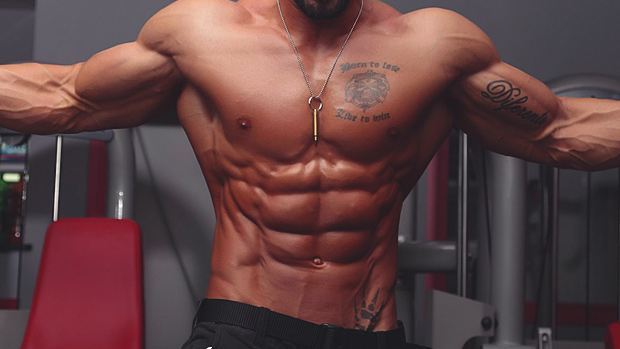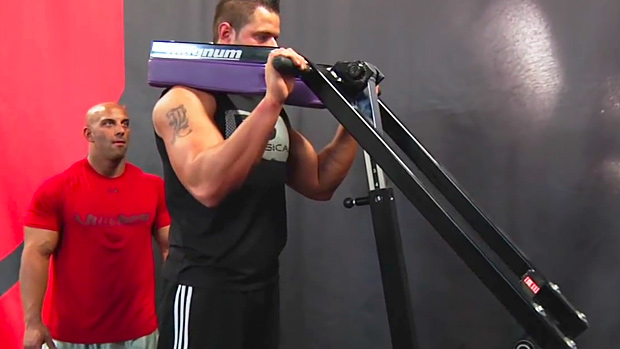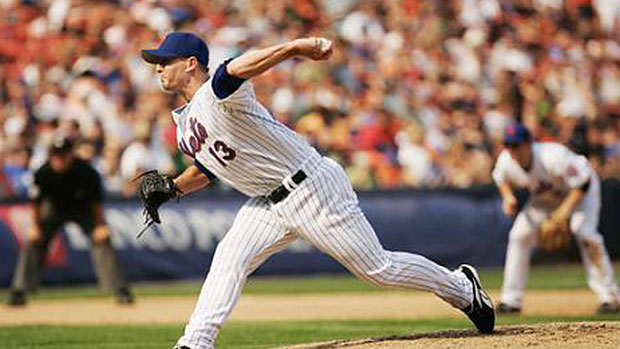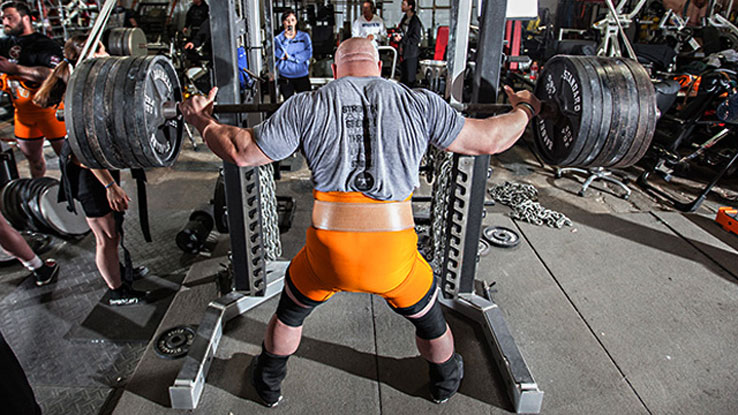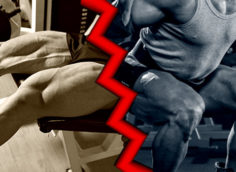I read a book recently called the Alphabet of Manliness. The author goes into vivid detail about why lumberjacks are awesome, how beef jerky is the best food ever, when it's acceptable to "sneak a peek," why Chuck Norris is a force to be reckoned with, and many other intricacies that embody manliness.
Needless to say, it's a literary classic and ranks right up there with the likes of John Steinbeck, Ernest Hemingway, and Jenna Jameson. Okay, okay, I wouldn't put it in the classic category, but it did set off a light bulb in my head.
I decided to come up with an unofficial "alphabet" geared more toward the fitness industry. Included are many of the terms, phrases, concepts, and miscellaneous tidbits that many newbies (and veterans) in the industry come across but may not fully understand. One thing is for sure, however: Chuck Norris's beard sharpens razors.
A is for Accommodating Resistance
In general, accommodating resistance refers to the concept of increasing muscular strength throughout the complete range of joint motion. Better yet, you can technically refer to it as a way to sustain near maximal force throughout the complete range of joint motion. This is the basic premise behind the use of bands and chains.
There comes a point when you're doing an exercise (squats for example) where the force generated during the movement is less at certain joint angles compared to others. This is why you can handle more weight with one-fourth squats than you can with full squats (force-velocity curve).
Add chains into the mix – where the squat is "deloaded" in the bottom position and "loaded" in the top position – and you can see how using chains can be highly beneficial in terms of strength gains.
Another great example is pull-ups. Instead of using the assisted pull-up machines that offer a counterbalance for trainees (hence, the lifter isn't able to sustain maximal force throughout the duration of the movement), I like to use bands.
In doing so, you get a little "boost" at the bottom position (where you're weakest), and as you get closer to the bar, you're getting less "help" and pulling more of your own body weight (where you're strongest due to the improved joint angle).
B is for Better Tissue Quality
In their article, 15 Ways to Foam Roll, Eric Cressey and Mike Robertson discussed the many benefits of using a foam roller to improve soft tissue quality.
Static stretching is great for improving range of motion, but stretching alone does nothing as far as improving the quality of soft tissue. Additionally, one of the great benefits of foam rolling is that it breaks up all the adhesions and scar tissue that builds up over time from a sedentary job/lifestyle.
There really is no excuse not to do it. Get a foam roller for crying out loud!
C is for Cookie-Cutter Programs
I see it all the time: personal trainers or strength coaches using the same routine with every single client or athlete, and more often than not getting less than optimal results. It should be no secret that what works for one person may not work for the next. Unfortunately, a vast majority of trainers and coaches just don't care or are too lazy to actually learn how to design their own training programs.
If you walk into any bookstore, you'll undoubtedly find numerous books proclaiming to be the best training book ever written, results guaranteed. There are some fantastic books out there; however, if you look at the standard bell curve, you'll see that such a claim is impossible.

Any given program will work for about 68% of the population. The further you move away from the mean score, the less likely any given program will be successful. In the end, about 30% of the people who buy the book get shafted. Worse yet, they'll pay a trainer a lot of money to put them on some cookie-cutter program that doesn't take into consideration their individual weaknesses or musculoskeletal imbalances.
Conclusion? If you're a trainer or coach, don't be a lazy asshole. Learn to write your own programs catered to the individual, especially if someone is paying you.
D is for Dawson, Rosario
Depending on what part of the country you're from, it's safe to say that Rosario Dawson has the best:
- Northeast: rack
- Southeast: knockers
- Central: fun bags
- North: sweater puppies
- Mid-West: tig ol' bitties
- North-West: dairy cannons
- West: face pillows
- ...ever
E is for Eat for Your Goals
I'm going to keep this one short and take on the role of Captain Obvious for a second. To gain mass, you need to eat more. To lose fat, you need to eat less.
Why some people just don't get it perplexes me. I do realize that it's a bit more complicated than just eating more or eating less, but I also think that people worry too much about the minutia, take things out of context, and make things more complicated than they really are.
Note: If you're 6'2" and 160 pounds and you're one of those people who says that he "eats all day," well, you're still not eating enough. Or you have a tapeworm.
F is for Fitness-Fatigue Model
Vladimir Zatsiorsky summarized the fitness-fatigue theory (or two factor theory) by stating, "The immediate effect after a workout is considered a combination of (a) fitness gain prompted by the workout and (b) fatigue. The summation of positive and negative changes determines the final outcome."

Fatigue will always mask your "true" fitness level. Many trainees (myself included) make the mistake of constantly pounding away each and every week, adding more and more volume. Inevitably, performance drops and a whole lot of frustration ensues.
In general, just learning how to fluctuate your training volume on a weekly basis will go a long way to help prevent fatigue from deterring your progress in the future. I can attest to this. I was going through a "funk" not too long ago and not making much progress in the gym. I just felt really rundown, tired, and weak.
Unfortunately, I continued to pound away each week. I decided to back-off for a week (deload) and low and behold, I came back the following week and broke a PR with a 560 pound deadlift.
You can't expect to set personal records each and every week, and if you're one of the many who feel that in order to make progress you need to constantly add more and more volume each and every week, then you're really shooting yourself in the foot. Again, fatigue will always mask fitness. Keep your ego at the door and learn to back-off when needed.
G is for General Physical Preparedness (GPP)
In recent years, GPP has gone from merely a way for powerlifters and strongman competitors to get some additional conditioning and recovery work into their training week (sled dragging for example), to guys performing "lawn mower sprints" while mowing their lawn and counting it as their GPP work for the day.
Alwyn Cosgrove said it best: "Where I'm from, carrying stones, dragging logs, and chopping wood is called work." I couldn't agree more.
Case in point: My family owns a lumber business and we have a sawmill behind our house. Growing up, I'd spend many weekends chopping and stacking firewood. The last thing on my mind was how "cool" it was that I was getting my GPP in. (I did look cool in a plaid shirt, though.)
I'm certainly not one to rain on someone's parade, so if they wish to use hard physical labor as a means to get into shape, then go for it! Just be careful not to slice off a foot. And self-propelled mowers don't count, tubby.
H is for High Intensity Interval Training (HIIT)
First off, if you're a beginner and/or if you're 40 pounds overweight, you don't need to be doing HIIT. I'm often amazed at how quickly some trainers will advocate HIIT for someone who's just starting out or who's drastically overweight and out of shape. More often than not, they aren't ready to do something so demanding and will just end up hurting themselves.
Instead, for the first few weeks, most (if not all) aerobic activity should be in the form of steady state cardio. Once they've developed a solid base of conditioning, you can then start to implement more HIIT style training into their programming.
That aside, HIIT is a superb way to get into badass shape and to promote increased fat loss. Essentially, HIIT is bouts of higher intensity "sprints" with intermittent lower intensity recovery/rest periods, usually in a 2:1 or 3:1 (work:rest) ratio.
Because of the increased EPOC (Excessive Post-Exercise Oxygen Consumption) after training, HIIT is far superior to steady state cardio as far as fat loss is concerned. However, many people fail to realize that it's very demanding on the central nervous system, so I recommend that most only perform one or two sessions per week. You certainly don't want to get into the "more is better" mentality here.
I is for Isometric Training
An isometric muscle action is an action where the length of the muscle doesn't change throughout the duration of the movement (e.g. pushing against a wall). Essentially, there are several key theories (key word: theories) behind implementing isometric holds into a program:
- Maximum Recruitment of Muscle Fibers: Teaches the CNS to fire all muscle fibers.
- Increased Strength at Weak ROMs: However, there's only about a 15-25% carryover to other ROMs.
- Injury Reduction: Little to no wear and tear on the joints. Perfect for training around injuries.
- Increased Tension
- Mental Toughness: They hurt (but in a good way).
I've actually implemented isometric holds in many of my clients' training programs with great success, particularly with clients who have knee, lower back, or shoulder issues. I've also used them with many of the younger athletes I train and include them in my own deload weeks. Throw in a few sets during the week to change things up a bit.
Editor's Note: Here's a great T-Nation article on isometric training.
J is for Jerky
I can't think of many things more perfect than beef jerky. Okay, maybe Kate Beckinsale in a tight black outfit, but after that, not many things top it. As a matter of fact, if I had to rank the top five manly things in the world, they'd be:
- Eating beef jerky
- Leaving the toilet seat up and not giving a damn
- Goodfellas
- Drop kicking any man caught dancing to the Macarena
- Calling your mom every weekend.
On a serious note, beef jerky is a great snack for those busy-body types. I work with many clients who sit in an office all day and have little to no time to get meals in. I always recommend that they put a bag of beef jerky in their desk drawer. It's easy to store, it's a high protein/low-fat snack, and depending on what brand you get, it's low carbohydrate as well.
K is for Ketosis
When carbohydrates are absent or deficient in the diet, the body will enter a state called ketosis, where overall metabolism shifts from the utilization of glucose for fuel to fat. The end result is the formation of ketone bodies, which are the by-product of the incomplete breakdown of free-fatty acids in the liver.
For fear of all the hate mail I'd receive if I delved any further, and the fact that this particular topic could constitute an article in and of itself, let's just say that I'm not a big proponent of ketosis. I just think for all the work that's put into actually reaching "true" ketosis (if you can actually attain it), people would be better off just cleaning up their diets and training the right way.
L is for Lift Heavy Shit
I think this is pretty self-explanatory. Train to get stronger and everything else will fall into place.
I just feel that people in general would make better progress if they added more weight to the bar. Not only will they see improvements in their body composition (increased lean body mass and decreased fat mass, assuming their diets are in check), but their confidence will just blow through the roof.
Yet I'm often dumbfounded when I hear people say, "Why should I train to get stronger?" Even worse is when I hear trainers say the same thing!
I currently train a woman who not too long ago told me one of the most asinine stories I've ever heard. She was searching for a gym with qualified trainers to help her reach her goals. In the past, she'd worked with a trainer that had emphasized strength training, and as a result she'd made outstanding changes to her body.
She ended up showing a new trainer what she'd done in the past. He replied, "Clearly your previous trainer cared very little about your well-being. This is strength training; why would you care about getting strong unless you're going to compete? If you really want to transform your body, you should train with me."
He then proceeded to explain that he'd have her perform 100-repetition sets of leg extensions, and that he'd often perform 400-repetition sets himself while reading a magazine. Needless to say, she hightailed it out of there and I'm currently training her to be able to overhead press this moron through a window.
M is for More Essential Fatty Acids (EFAs)
While there are literally hundreds of advantages in adding EFAs to your diet, some of the more profound ones include:
- Cardiovascular health (decreased incidence of atherosclerosis, hyperlipidemia, and hypertension)
- Decreased incidence of inflammation in joints and connective tissue (arthritis)
- Increased insulin sensitivity
- Increased fat oxidation
- Improved distance on your drive off the tee
- Better gas mileage
- The ability to actually understand what's going on in Lost
Okay, so the last three won't happen, but given the plethora of advantages that EFAs have in the diet, you really have no excuse not to be taking them.
N is for No More Crunches
Many people spend the majority of their time in front of a computer and, as a result, end up with very kyphotic posture (rounded shoulders and thoracic spine), tight hip flexors, no gluteal function, and lower back pain. The last thing they need to do is more crunches, where many of the aberrant motor patterns causing the issues in the first place are reinforced. Yet walk into most gyms and you'll see trainers having their clients perform any variety of crunches to get their abdominal work in.
The abs work in a variety of planes and movements, and it's important to train them as such. Most notably, it's important to emphasize stability, since by definition that's the main function of the abdominals in the first place. While I do think that crunches hold merit and do have their place for certain individuals, I also feel that they're over-emphasized and cause more harm than good for the vast majority of the population.
Here's a little refresher on the different planes of core training. They're listed from most important to least important.
- Stabilization
- Rotary (preventing/resisting unwanted movement, specifically in the lumbar spine)
- Hip Flexion
- Trunk Extension
- Lateral Flexion
- Trunk Flexion
- Rotation
If you notice, the last two on the list are what most people emphasize when they train their abdominals. Many would be wise to omit these entirely from their programming for the time being and focus more on movements toward the top.
O is for Off-Season Training
Without a doubt, Eric Cressey hits the nail on the head with his latest project, The Ultimate Off-Season Training Manual. He finally sets the record straight as far as how one should train during the off-season to better prepare for the upcoming season.
In short, Eric goes into great detail about why athletes should minimize involvement in their sport in the off-season (it's called the off-season for a reason). Instead, they should use this time to recover and then focus on getting stronger. Unfortunately, many athletes and coaches miss the boat entirely and end up "extending" their season or emphasizing more metabolic conditioning, which usually leads to accumulated fatigue and, in the end, a tired, weak athlete.
I can honestly say that if I had access to this manual during my playing days, I would've been an entirely different athlete. It pains me to think of how thoughtless I was with my training back then, and how much time I wasted. If you're currently an athlete or just someone who's looking to get stronger, you'd be hard pressed to find a more thorough guide to help take you to the next level.
P is for Posterior Chain
Many people still don't know exactly what the posterior chain is and how to effectively make it stronger.

The posterior chain refers to the hamstrings, glutes, adductor magnus (also a powerful hip extensor), and lower back. Because people spend the majority of their day sitting in front of a computer at work or playing video games, many tend to be drastically tight and/or weak in this area.
The technical term used in this case is lower cross syndrome, where a specific pattern of tightened and weakened muscles are prevalent. In this case, the tight muscles usually include the hip flexors, lower back, and hamstrings. The weak muscles consist of the glutes and abdominals.
As far as how to strengthen the posterior chain, it really comes down to structural balance. When training the lower body, many people don't train it with near the intensity as their upper body. Likewise, when they actually do train their lower body, it usually consists of some squat variation, leg press, leg extensions, and maybe some leg curls thrown in for good measure.
Simply put, you just have to be more cognizant of balancing out your training with more hip dominant movements such as conventional deadlifts, Romanian deadlifts, glute-ham raises, good mornings, pull-throughs, lunge variations, and one-legged RDLs to name a few. Doing so will go a long way toward improving strength and performance, and creating an aesthetically pleasing body.
Q is for Quadratus Lumborum
Any time you can squeeze the word quadratus lumborum into a sentence, you'll automatically sound smarter. Try it sometime.
Outside of that, it's interesting to note that when one hip is higher than the other, it's usually indicative of a tight QL. I come across this in many of my clients. To help correct it, I recommend a few things:
- Soft tissue work on the TFL/IT Band. Loosen up this area and the QL won't have to fire (hence, shorten) so much to compensate.
- Strengthen the glute medius. X-band walks would be ideal in this scenario (see below).
- Hip corrections as part of a dynamic warm-up
After a few weeks, you should see and feel a vast improvement in your hip mobility.
R is for Road House on DVD
'Twas a glorious day when the Patrick Swayze cult classic, Road House, was released on DVD. If you have a hankerin' for bar fights, stone washed jeans, cheesy kung-fu, monster trucks, or mullets, look no further.
S is for Static Stretching
When most people think of static stretching, they think of hoisting their leg up onto a table and stretching their hamstrings. The main problem with this approach is that it only stretches the hamstrings in one plane (saggital). As trainers and coaches, we don't tell people to train in one plane, so why do we miss the boat and stretch people in only one plane?
Up until a few weeks ago, I was a culprit of this travesty as well. Lucky for me, I was invited to a seminar hosted by Mike Boyle in Boston dealing with program design, and he brought up something so simple it made me realize how stupid I was: stretch in different planes! Brilliant.
Keeping with the hamstring example, if you were to place your leg up onto a training table, you'd be stretching in the saggital plane. Now in order to stretch the hams in the frontal plane, all you'd have to do is slide your pelvis side-to-side:
To stretch in the transverse plane, you'd simply rotate your pelvis:
I'm willing to bet the majority of people who try this will be very tight in their lateral hamstrings.
T is for Training, not Working Out
Many people say they're going to the gym to "train," but what they really end up doing is working out. To help clarify the differences between the two, I made this easy to follow chart:
| Someone Who Trains | Someone Who Works Out |
|---|---|
| Sweats | Complains that it's too hot in the gym |
| Listens to Rage Against the Machine | Listens to Lionel Ritchie |
| Is catching his or her breath between sets | Is reading who Paris Hilton is currently banging in this week's gossip mags |
| Wears Chuck Taylors | Wears a headband |
| Refuses to sign up at a gym that doesn't have a power rack | Is ecstatic the new line of ellipticals are arriving |
| Is proud of the calluses on his hands | Uses gloves while performing lat pulldowns |
| Looks forward to deadlift day | Would rather do leg curls |
Hopefully that clarifies the difference between the two.
U is for Unilateral Work
Specifically, I'm referring to lower body unilateral work: training one leg at a time. It's not fun, and hence not many people do it. If people would be more aware of implementing additional lower body unilateral work into their programming, I can guarantee they'd see the following changes:
- Correction of any weaknesses or imbalances that may exists between one leg or the other.
- Improved athletic performance. Name one sport that takes place entirely on two legs? Even bowlers end up on one leg!
- Improved strength. One-legged strength is completely different than two-legged strength and needs to be trained in a specific manner.
- Better proprioception (balance) and kinesthetic awareness (knowing where your body is and having the ability to control it).
- Improved knee health. Lower body unilateral work improves glute function, which in turn takes a lot of the burden off the knees and lower back.
V is for Volume (Learn to fluctuate it)
As mentioned above, fatigue will always mask your true fitness. You can't expect to consistently add on more and more volume (in this case, number of total sets and reps) each and every week and make continued progress. Unless you're using "assistance," it's virtually impossible. This is why I like for trainees to learn how to fluctuate their training cycles:
- Week 1: High
- Week 2: Medium
- Week 3: Very High
- Week 4: Low (deload)
It's really nothing revolutionary and is used by many strength and conditioning coaches. As far as what variables need to be adjusted to accommodate for a varied training volume, it depends on the individual/athlete. Some adjust well with varying their assistance work. Here's an example:
Incline Dumbbell Press
- Week 1: 4x8
- Week 2: 3x8
- Week 3: 5x8
- Week 4: 2x10 or 2x5
Others do well with adjusting their ME (max effort) work:
Box Squat
- Week 1: 7 singles over 90%
- Week 2: 5 singles over 90%
- Week 3: 10+ singles over 90%
- Week 4: 3 singles over 90% or rep work (3x5)
Again, it can be highly variable depending on the person, but either way, what will usually be adjusted is either the assistance work or the ME work (or both). You'll have to play around with things to see what works best for you. The important thing to realize is that you should get into the habit of varying your training volume each week for continued success.
W is for Warming-Up
How do you warm-up? I'm willing to bet that many of you still replied with "Ten minutes on the stationary bike and then a few stretches." How this is possible, especially at a time when the term "dynamic flexibility" is practically everywhere, is beyond me.
How is peddling on a bike and then stretching your quadriceps going to prepare you for a bench session? More importantly, how's that going to loosen up those "trouble spots" that plague about 90% of the population (e.g. hip flexors, glutes, scapula, and lower back)?
If you haven't guessed it, you should be doing some form of a dynamic flexibility warm-up prior to each training session. In doing so, you'll better prepare the body for the more dynamic nature of resistance training and more than likely improve performance as well. Not only that, but I can guarantee that you'll feel a ton better.
X is for X-Band Walks
I mentioned these above when I discussed the quadratus lumborum. (See, didn't I just sound really smart using that in a sentence?) I think that this movement is superior to anything as far as glute medius strength/activation is concerned.
So why the need for glute medius activation? Simply put, one of the main jobs of the glute medius is to control the femur. When it's weak or "turned-off," it can't do what it's supposed to do, and the knees end up buckling or caving in when you squat. Not only do you get great activation, but it also promotes scapular retraction and thoracic extension, which many people are in dire need of as well.
Y is for Yohimbe
Specifically, I'm referring to yohimbine HCL (the drug form). Yohimbe comes from the bark of a tree that grows in West Africa. In light of the recent ban on ephedra, many people have reverted to other means to help with "stubborn" fat loss, and yohimbe has grown in popularity in recent years.
First and foremost, I'm a firm believer that supplements are progress enhancers, not progress stimulators (another Cosgrove quote). If you're not making progress through training and diet alone, then a supplement won't really make that much of a difference (except to empty your wallet).
That being said, yohimbe is really effective at targeting those stubborn fat cells (specifically by inhibiting alpha-2 adrenoreceptors). For women this tends to be hips and thighs; for men it tends to be belly and lower back.
It should be noted that yohimbe only really works for those people who are already pretty lean. I'd say for men this would constitute anywhere between 10-12% bodyfat, and for women, 18-20%. If you're above these marks, focus more on your training and diet.
As far as effective dosing is concerned, many experts advocate 0.2 mg yohimbe (remember, use the HCL version) per kilogram of bodyweight, or about 0.1 per pound, used with 100-200 mg of caffeine. So for example, a 200 pound male would use 20mg of yohimbe with 100-200 mg of caffeine about 30-60 minutes before steady state aerobic activity.
A good rule of thumb to follow is to start with half the recommended dose to see how you handle it and adjust from there.
Z is for Zatsiorsky, et al.
If you're in the fitness industry, you should be reading books, not magazines. Some that I recommend are:
- Science and Practice of Strength Training by Vladmir Zatsiorsky
- Essentials of Strength Training and Conditioning by the National Strength and Conditioning Association
- Facts and Fallaciesof Fitness by Mel Siff
- Ultimate Back Fitness and Performance by Dr. Stuart McGill
- Starting Strengthby Marc Rippetoe and Lon Kilgore
- Natural Hormonal Enhancement by Rob Faigin
- Functional Training for Sports by Mike Boyle
- Vertical Jump Bible Development Bible by Kelly Baggett
- Theory and Application of Modern Strength and Power Methods by Christian Thibaudeau
I could literally go on and on, but I think the above list would constitute a solid foundation for anyone just starting out in the industry.
And Now You Know Your ABCs
Hopefully I was able to shed some light on a few of the more intricate terms and phrases that you may come across in the industry, and maybe you learned a thing or two in the process. If not, I think we can all agree that you should be calling your mother at least once per week and that the world would be a better place if more people deadlifted.

